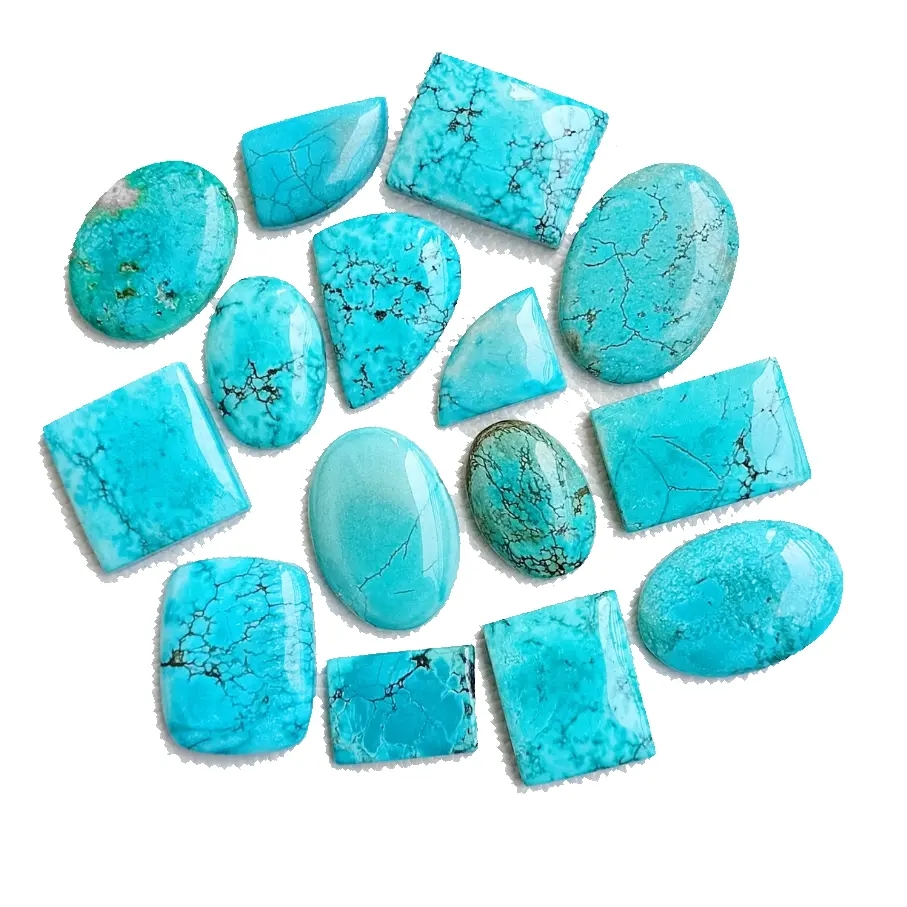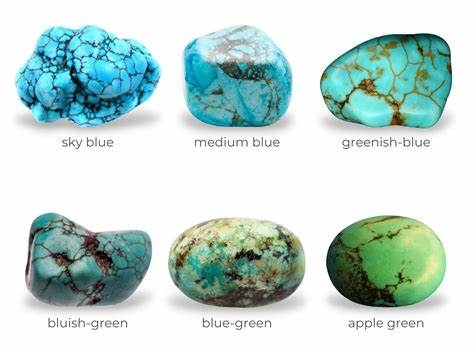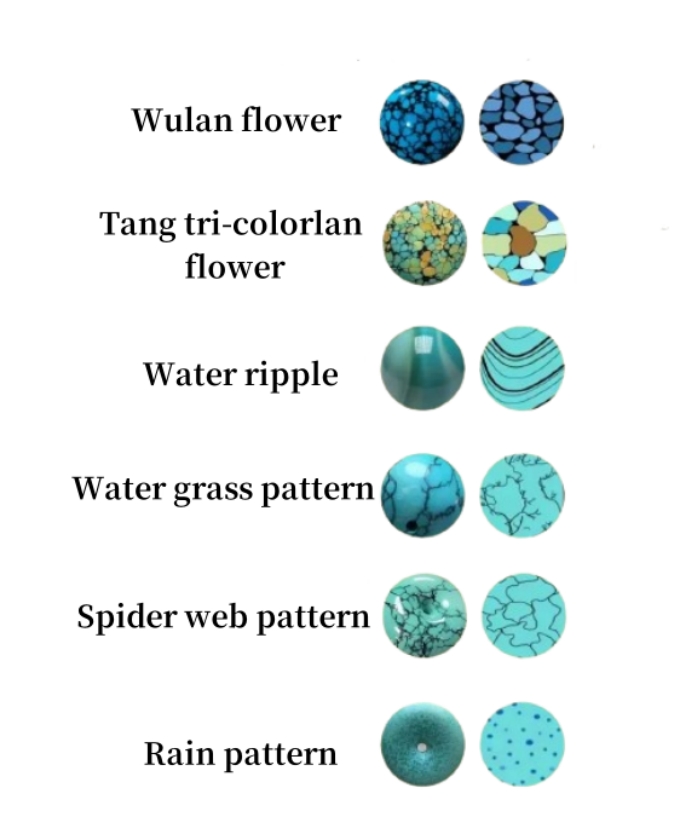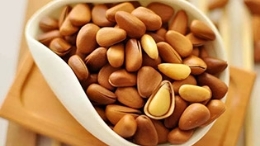🟦Turquoise is one of the oldest gemstones. It has a distinctive sky blue to green color due to the presence of copper and ferri. The name Turquoise is derived from the 17th century French word “turquois”, meaning Turkish, because turquoise was first mined in Khorasan, Persia, and entered Europe through Turkey, and the Chinese name is also translated as Turkish stone. Turquoise is also the birthstone of December.
🔹Hardness: 5-6 (Porcelain Pine)
🔹Refractive index:1.61-1.65
🔹Density:2.76
🔹Characteristics: Nodules, diffuse coloring, frank veins
🔹Fracture: shell-like to pull-like
🔹Transparency: usually opaque
🔹Lustre:greasy glassy luster on polished surface, greasy dull luster on fracture
🔹Inclusions:Often black speckled or black linear brownish ore or other iron oxide inclusions


✅Turquoise Colors
👉Turquoise ranges in color from dark green to grass green to a bright, medium-toned sky blue, with the opaque azure blue being the most valuable. Turquoise varies in color depending on the elements contained in the oxides of the original stone, it is blue when it contains copper and green when it contains ferri.
🔵Blue series: The common color of blue, including azure and light blue.

🟢Green series: Ranging from light green to dark green.

🟡Yellow-green series: With a hint of yellow tone, presenting a unique visual effect of warm tones.

✅Turquoise pattern
👉The interior and surface of turquoise often have naturally formed textures, called “ferri lines”, which are black and brown lines formed by the penetration of minerals such as copper oxide and iron oxide, and these natural textures give turquoise unique characteristics.
✨Turquoise often has the pattern of wulan flower, Tang tri-color, spider web pattern, water grass pattern, water ripple, rain pattern. Among them, wulan flower, water grass pattern and so on are also one of the representative and popular patterns.

✅Turquoise origin
👉Turquoise is mined in Afghanistan, Argentina, Australia, Brazil, China, Chile, Egypt, Iran, Israel, Mexico, the southwestern United States, and Tanzania.
🔊China is currently the world’s largest producer of turquoise, and its production areas are mainly concentrated in Hubei. For example, the turquoise produced in Zhushan County and Yunxian County in Hubei Province, China, is famous for its large size, sky blue, uniform color, soft luster, slightly transparent and good porcelain degree, and is an internationally recognized high-quality turquoise resource.
👉In Iran, a famous turquoise producing place abroad, it produces the best quality porcelain pine and iron wire pine, known as Persian turquoise.
✅Selection of turquoise
🔍Look at the Porosity: Fineness refers to the fineness of the mineral particles that make up turquoise and how closely they are bonded. Porcelain and fineness are complementary, the finer the particles combined more closely, then the better the porcelain, the higher the quality. Turquoise porcelain for the king, high porcelain turquoise material is delicate, warm touch, plate play effect.
👉Porosity is an important indicator for evaluating the quality of turquoise, which actually refers to the density, hardness and luster of turquoise. According to the different porosity, turquoise can be roughly categorized into the following grades:
- Bubble pine (face pine): Large porosity, loose texture, almost no luster, similar to chalk-like, not easy to preserve the oil, disk play effect is not good.
- Hard pine: Porcelain is slightly higher, but still not hard enough, gloss has improved.
- Porcelain pine: Higher degree of porcelain, texture, surface as porcelain, glossy, strong, after playing to achieve a very good effect of pulp, long time to play may reach the state of jade.
- Jade pine: The highest degree of porcelain, the texture is as delicate and warm as jade, the sense of transparency is very strong, the market value is very high.
🔍Look at the clarity: Turquoise is a mixture of ores, often contains ferri threads and other impurities, without any imperfections of the turquoise is rare, the price is also ridiculously high. In principle, the less ferri threads on the surface, the better, but as long as the ferri threads are evenly distributed, the more beautiful the pattern, then the higher the value. Like Orchid, the surface has uniform iron lines, is the iron line turquoise family in the rare high-end products.
🔍Look at the iron line: The original turquoise iron line distribution natural, clear. Fake turquoise iron line distribution is uniform, thick and thin towards the regularity of the iron line, iron line end is not natural, the color of the iron line is basically the same.
🔍Look at the color: Natural turquoise color natural, colorful, while the color of fake turquoise will generally be different from the common turquoise color, very unnatural. Common colors are sky blue, dark blue, light blue, green, blue-green, yellow-green, light green, etc., generally the bluer the better. However, the production of blue is very low, so be vigilant when encountering a very low price of high blue.
🔍Look at the reflection: Turquoise porcelain is associated with the color, refractive index, fake turquoise refractive index floating in the table or a gelatinous sense of reflection.
✅Turquoise Maintenance
⚠Most turquoise has pores on the surface, which will absorb hand rubbing oil, lip balm and perfume, etc. When wearing it, you should pay attention to stay away from sweat, oil, etc. Avoid excessive contact with cosmetics and skin oils to avoid damaging the gemstone.
⚠Turquoise is afraid of high temperature, not direct fire and direct sunlight, so as to avoid fading, cracking, dry crack. Turquoise hardness is not big, in wearing the preservation should be avoided and other hardness of the jewellery or objects collision.
Follow us to learn more about jewelry.Follow us to learn more about jewelry knowledge.


